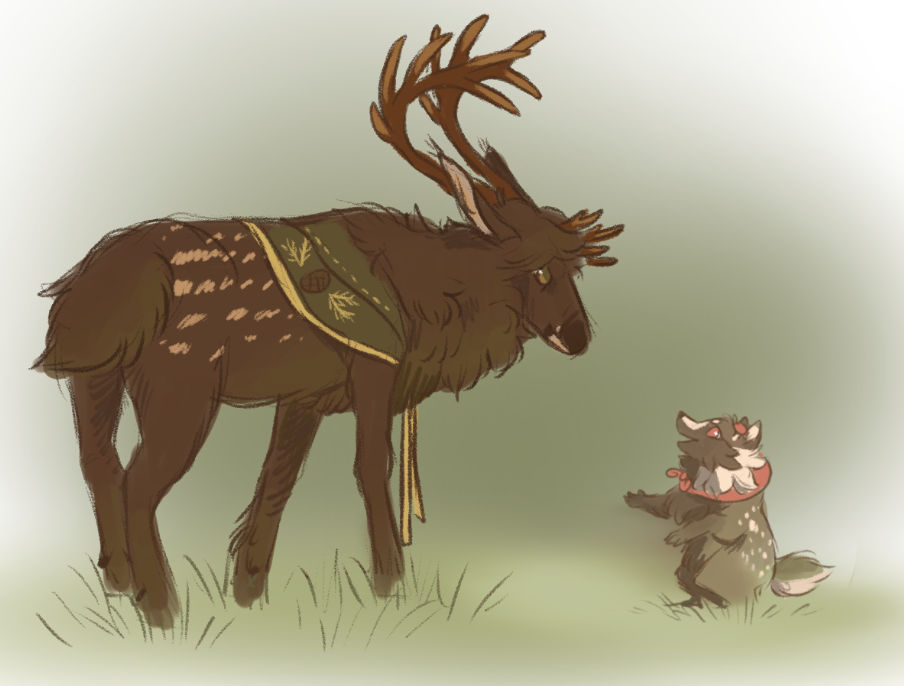Shroomkin are raccoon like forest dwellers that share a life-long bond with a fungus. They live on both of the continents Silkkassa and Miatas.
TABLE OF CONTENTS
- Biology
- Developement
- Diet and Activity
- Habitat and Homes
- Society
- Accessories
- Relationships with Aitielkh, Bepotelkh, & Humans
biology
Shroomkin tend to stand around 1’ (30.4cm) at the shoulder. They have sharp, retractable claws used for climbing and delicate tasks, but only begrudgingly used for digging. Their thumbs are opposable. They are mammalian, covered in fur and bearing live young in litters of 1-3, once a year or less as they desire. Their lifespan is anywhere from 20-50 years, 50 being considered rare and highly respected if achieved (they count their age in seasons, however, so 50 years would be considered 200 seasons).
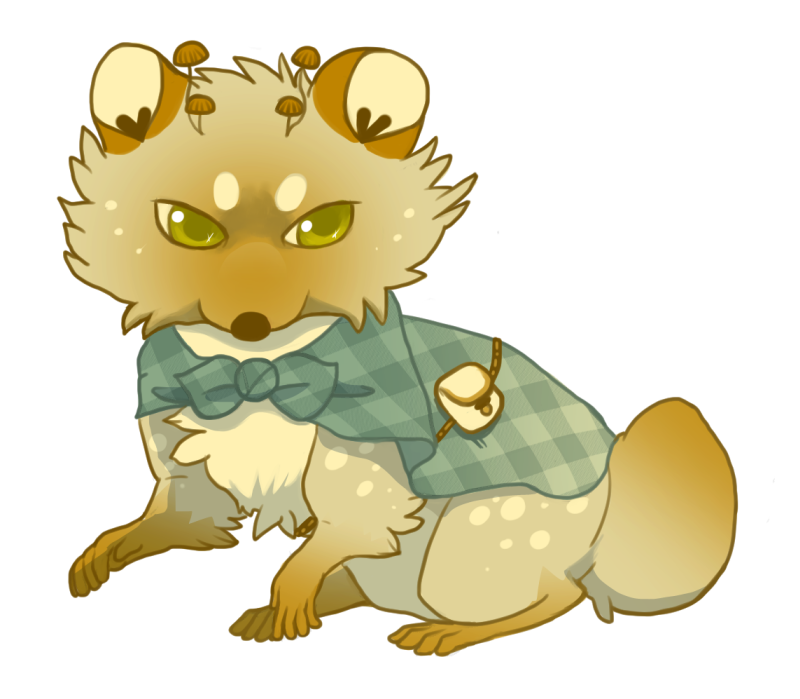
Sono shroomkin
Shroomkin living in Miatas mostly live in the mountains were it is cooler and more water available to spread their spores. They do come venturing out into the desert however they strictly avoid human inhabited areas.
Sono shroomkins differ slightly biologically. They generally have a longer snout, long tails and non-retractable claws. Just like in Silkkassa some rarer shroomkin may have differently shaped ears and tails.
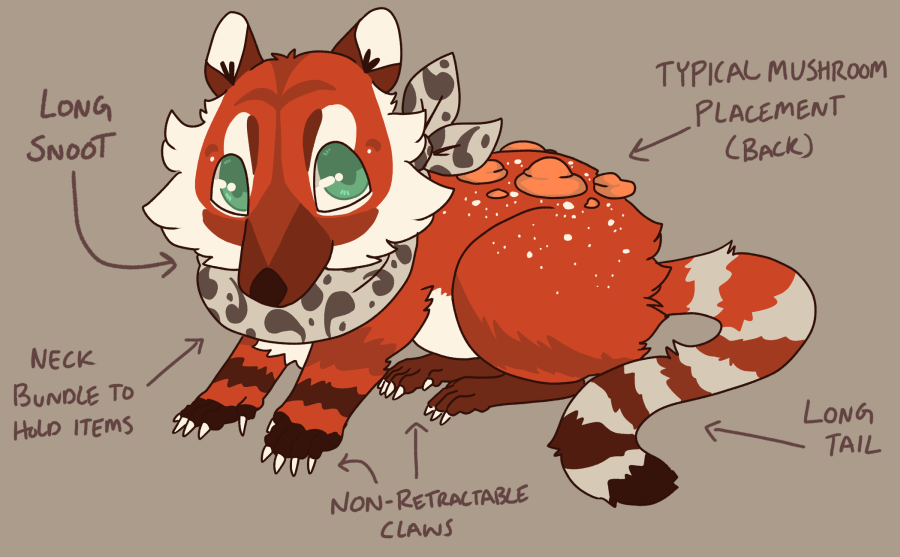

developement
Young shroomkin are born a gray-brown with white dappled on their back and head, and eyes a dark brown. Once they eat their first mushroom (which they must seek out themselves around two seasons of age), the symbiotic relationship is formed as the fungi becomes a part of them. At this time, their colors begin to change and they develop a distinct look. Once the fungi fruits on their head, they are considered an adult (typically at 4 seasons of age). The fruiting fungi will fall off and be replaced periodically. Shroomkin shake the spores of their fungi into pans, which are then carefully poured into their spore pouches to be carefully distributed within the surrounding forest, providing food for all.
cordyceps shroomkin
Juvenile shroomkin who do not get proper guidance from their parents or clan may mistakenly eat a cordyceps mushroom.
These mushrooms take over the shroomkin's body in a parasitic fashion leaving the shroomkin drab colored and zombie-like.
These shroomkin become pariahs, with any encountered shroomkin clans chasing them away despite their natural desire to approach others of their kind.
The cordyceps cause the shroomkin not to feel pain or emotion. They live short lives, dying once the cordyceps have taken over their body completely. The mushroom spreads its spores and that area becomes infected and a high risk for foolish young shroomkin.
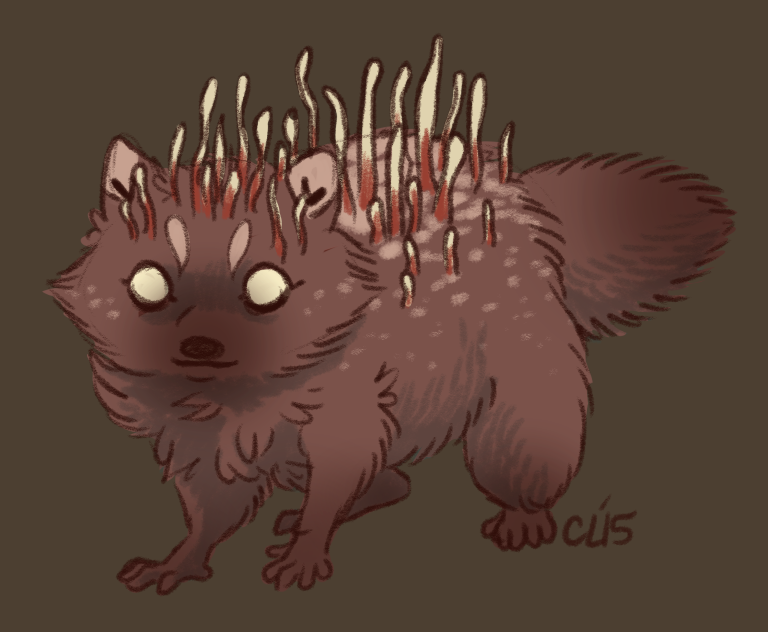

diet and activity
Shroomkin eat fungi indiscriminately and are immune to any harmful effects that might poison other creatures. They will also eat plants, fruits, nuts, and insects. They may gather particular herbs in the spring, summer, and fall, and dry and store them for future medicinal use.
Most Shroomkin are not picky about sleep schedules. Some may prefer to wake at night and some in the day, with others sleeping and waking every few hours night and day. However, day is most convenient as it provides a source of light. Though Shroomkin can see fairly well in the dark, they may prefer the advantage of sunlight, which confers colors and makes it easier to spot danger
Because of their fairly secretive nature, Shroomkin don’t have many predators. Furthermore, some Shroomkin who form relationships with poisonous mushrooms become poisonous themselves. In a sort of Batesian mimicry, all Shroomkin are considered a dangerous delicacy by potential predators, as one can’t always know which are or are not poisonous!

Habitat and homes
Shroomkin live in old-growth forest, where there are massive trees that let little light down to the forest floor. Moss, shade-loving ferns, and fungi flourish. There are clearings in places though, and in the rich soil of those clearings, many kinds of plants grow. Old trees that have fallen become nurse stumps, fostering many species of mushrooms, plants, and insects. Shroomkin prefer to start colonies within reasonable distance of a water source, especially rivers and streams.
Because the trees grow to such massive sizes, they provide excellent homes for Shroomkin. Old trees that have been weakened by fungi infestation become soft inside (known as “heart rot”), making them easy to carve out into homes. Shroomkin may chew and claw to make their dens in these trees, or they may use tools like sharpened rocks. Once the inside is smoothed out, it becomes a cozy home where Shroomkin not only sleep, but also store their belongings. The entrances are fitted with doors made from the trees bark, serving as crude camouflage, but there are small windows cut into them to allow Shroomkin to see out as well as circulate fresh air. Any one tree may support several Shroomkin and/or families. When colonies are present, there will be many inhabited trees in one area. Pine is preferred as the wood is quite soft.
Some shroomkin living in Aitielkh protected clans may build structures connected to their trees. These structures are made from wood and clay and cannot be seen by the human eye.
Shroomkin that live in clans protected by aititelkh may do things like craft with wood and fabric, create rudimentary ceramics and design primitive tools (when provided fire by an aitielkh's magic). They do not have access to paints, glass or anything beyond crude metallurgy. Some shroomkin may use human artifacts bartered to them by beps or stolen from humans traveling through the woods. However shroomkin have such an antagonistic relationship with humans that some shroomkin may disapprove of anything related to or created by humans.
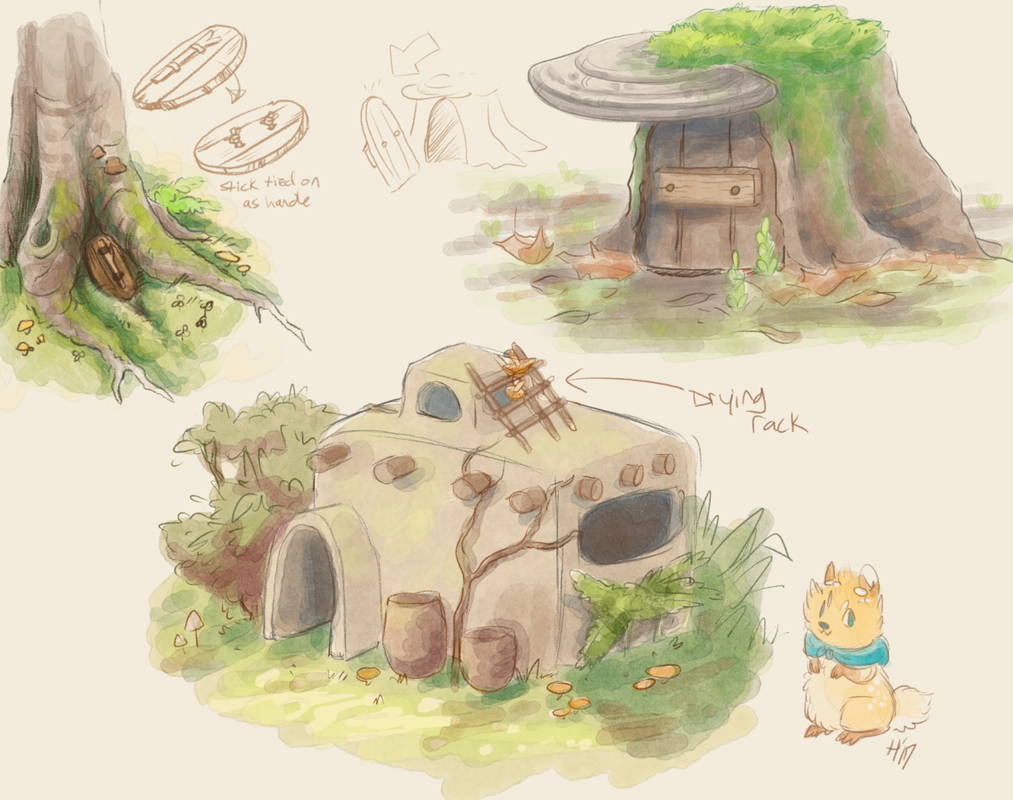

Society
Though they tend to live in solitary dens, Shroomkin prefer to live in communities of 10-30 individuals. They may stay with a beloved partner their entire lives, or they may just seek out temporary mates for the sole purpose of having offspring. Once the young are able to fend for themselves, they typically go on a journey to disperse to another colony. Because of these tendencies, Shroomkin tend not to share dens with others for long, except in some cases of extended monogamy.
In communal life, Shroomkin don’t necessarily take on particular roles, but rather everyone pitches in however they are able. However, not much is done communally as Shroomkin tend to take care of their own needs fairly well. There are gatherings on solstices and equinoxes in which the community comes together and shares stories and lore while indulging in shared food. Shroomkin tend to avoid firekeeping except at these gatherings, which are known as Spring, Summer, Fall, and Winter gatherings, respectively.
If two Shroomkin cannot sort out their differences, one will typically disperse to another colony for the sake of keeping peace. Because of this tendency, colonies tend to attract and maintain denizen of similar personality type. For example, one colony may be full of primarily rowdy members, while another might be mainly quiet and reserved. This can be a weakness, as different perspectives are sometimes needed to make a strong community. Some colonies may become notorious due to their perceived reputation for behaving a particular way.

Accessories
Once a Shroomkin has formed a relationship with a fungi and reached adulthood, they design a shawl or hood for themselves, as well as a pouch for keeping spores. Fabrics are made from dried and carefully handspun plant fibers, from things like inner tree bark, soft seedheads of plants, grasses, etc. Dyes are made from plants, minerals, nuts, and even insects. The shawls are designed with the Shroomkins personal aesthetics, but also may tell a story about their lives, fungi relationship, and personality.
Shroomkin also carry a container for their mushroom spores. The spore container can be a bag, a carefully carved box or anything else that can be made with natural materials. Some shroomkin may use items like metal clasps or small amounts of chain they have bartered for with passing by merchant bepotekh.

Relationships with Aitielkh, bepotelkh, & humans
Shroomkin communities often have one or more Aitielkh that protect their clans from humans using their illusion magic. These aitielkh also help out the shroomkin by providing fire for them to make primative tools. In return the shroomkin spread their spores at the aiti shrines and watch over said shrines.
Shroomkin will interact with wild beps and even barter with them. Some wild beps will exchange human goods or crops with shroomkin for shroomkin made accessories or elusive mushrooms. Shroomkin are more wary of beps who interact with humans but still may come up to one if their human companion isn't present.
Shroomkin have a strong aversion to humans. They don't trust humans and will not let themselves be spotted by them. Humans don't know that shroomkin exist, and if they were to look straight at a shroomkin, the aiti magic protecting them would make them invisible to the human.
